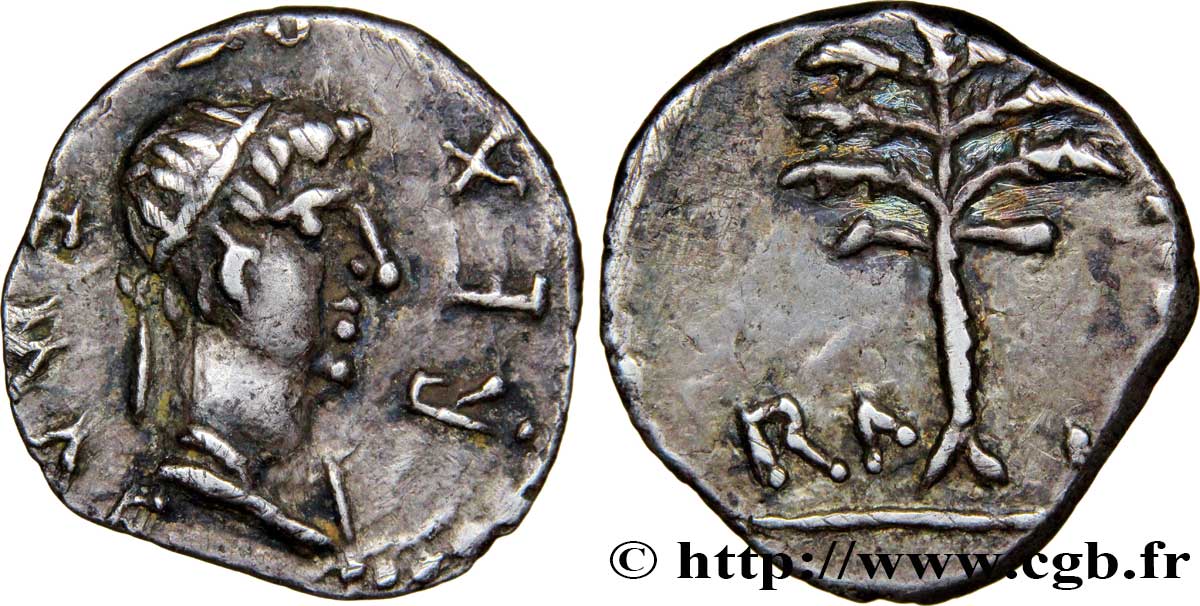v61_0046 - REGNO DI MAURETANIA - PTOLEMEO Denier
MONNAIES 61 (2014)
Начальная цена : 750.00 €
Назначить цену : 1 200.00 €
Цена реализации : 790.00 €
Количество ставок : 2
Максимальная предлагаемая цена : 800.00 €
Начальная цена : 750.00 €
Назначить цену : 1 200.00 €
Цена реализации : 790.00 €
Количество ставок : 2
Максимальная предлагаемая цена : 800.00 €
Тип Denier
Дата: an 1
Монетный двор / Город: Césarée, Maurétanie
Металл: silver
Диаметр: 14 mm
Ориентация осей монеты: 1 h.
Вес: 1,68 g.
Редкость: R3
Комментарии о состоянии
Exemplaire sur un petit ovale et irrégulier, court sur les légendes. Beau portrait de Ptolémée. Joli revers bien venu à la frappe. Belle patine de collection ancienne avec des reflets dorés
Ссылки в каталоге: :
Лицевая сторона
Аверс: легенда: REX - [PTOLEMAEVS].
Аверс: описание: Buste diadémé et drapé de Ptolémée à droite, (A’01).
Аверс: перевод: “Rex Ptolemaeus”, (roi Ptolémée).
Обратная сторона
Реверс: легенда: R A - I.
Реверс: Описание: Palmier.
Реверс: перевод: (règne an 6).
Комментарий
Poids très léger. Normalement, Ptolémée a succédé à son père Juba Ier en 23. Mais en fait, il est associé aux affaires depuis 20 après J.-C. La datation des années régnales devrait donc se faire à partir de cette date. Ce type semble beaucoup plus rare que ne le laissent supposer les ouvrages généraux. Sur cet exemplaire l’année régnale est difficile à interpréter. C’est normalement l’an I (20-21) mais le flan est court et le type est aussi connu pour l’an 2 (A. 251).
Very light weight. Normally Ptolemy succeeded his father Juba I in 23. But in fact he has been associated with affairs since 20 AD. The dating of the regnal years should therefore be done from this date. This type seems much rarer than general works suggest. On this example the regnal year is difficult to interpret. It is normally the year I (20-21) but the flan is short and the type is also known for the year 2 (A. 251)
Very light weight. Normally Ptolemy succeeded his father Juba I in 23. But in fact he has been associated with affairs since 20 AD. The dating of the regnal years should therefore be done from this date. This type seems much rarer than general works suggest. On this example the regnal year is difficult to interpret. It is normally the year I (20-21) but the flan is short and the type is also known for the year 2 (A. 251)








 Cообщить об ошибке
Cообщить об ошибке Распечатать страницу
Распечатать страницу Отправить мой выбор
Отправить мой выбор Задать вопрос
Задать вопрос Consign / sell
Consign / sell




